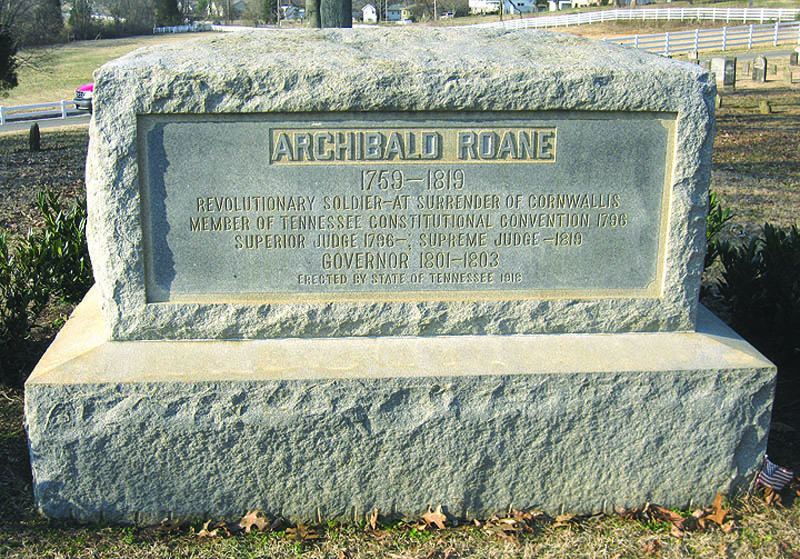Tennessee history for kids
Archibald Roane was Tennessee’s second governor

Roane’s grave in Farragut. (photo:Tom Bosse Photo for www.hmbd.org )
Roane was born in Pennsylvania in 1759. When the Revolutionary War broke out, his family sided with the rebellious Americans. Roane was a member of the Ninth Battalion of Pennsylvania militia that crossed the Delaware River with George Washington in 1776, and he was present at the surrender of Cornwallis in 1781.
After the war, Roane got a legal education and migrated to Tennessee. In 1790, in what may have been the turning point in his career, William Blount appointed Roane to be attorney general for the Southwest Territory’s Washington District.
Six years later, Roane represented Jefferson County at Tennessee’s first Constitutional Convention. We don’t know much about what he said at that convention, but we can see Roane’s signature on our state’s first constitution.
Tennessee’s first legislature chose Roane to be one of three judges on the state’s first Superior Court of Law and Equity – the early equivalent of the Tennessee Supreme Court.
John Sevier was Tennessee’s first governor. A man who had led his countrymen on countless military engagements against the American Indians, Sevier was formidable and powerful, and was reelected in 1797 and 1799.
In September 1801, Roane was elected to be Tennessee’s second governor in an election in which he was virtually unopposed (he received more than 99% of the vote).
We can safely conclude that he had approval of Sevier, the state’s extremely popular first governor.
As Tennessee’s chief executive, Roane tried to reform the Tennessee militia. He encouraged the federal government to create a road from Nashville to Mississippi. He also tried to deal with ongoing disputes with Kentucky and Virginia over the location of Tennessee’s border.
But none of those things mattered as much as a decision Roane made in 1803.
In February of that year, the highest-ranking officers of the state militia gathered to elect their major-general.
As fate would have it, the vote ended in a 17-17 tie between John Sevier and Andrew Jackson. The Tennessee constitution stipulated that the governor cast the deciding vote.
Roane would have been better off not coming to work that day, but he did, and he cast his decisive vote for Jackson. It later came out that Jackson presented Roane with evidence that Sevier had been complicit in the awarding of land grants to himself and members of his family.
Whether or not this evidence was significant in Roane’s decision will never be known. But Sevier – who was 22 years older than Jackson – denied all wrongdoing, and never forgave Roane.
When Roane’s term ended in 1803, Sevier ran against him and won by 6,780 to 4,923 votes. Roane ran against Sevier again in 1805, but lost again.
Roane went back to being a judge, and then a state senator from Knox County, and in 1812 was re-appointed to the highest court in Tennessee (later renamed the Supreme Court of Errors and Appeals). He was also a trustee of Blount College, Greeneville College and Washington College.
I believe that Roane was hounded by Sevier’s enemies for the rest of his life. “I have known for some time that I had inveterate enemies who would stoop to anything to injure my reputation,” Roane wrote in the Dec. 9, 1811, Knoxville Gazette.
You have to read between the lines to see the degree to which Roane’s reputation as governor was disparaged. Here are three examples:
• When Roane died in 1819, his Nashville Whig obituary downplayed his status as a former governor – only briefly mentioning it about halfway through the article. “He [Roane] was always actuated by the purest motives,” the Whig said, a sentence that could be interpreted any number of ways
• In 1822, when Roane’s daughter Anne married, the Knoxville Intelligencer said she was the child of “Archibald Roane, Esq.” but didn’t point out that the man had been governor.
• When Roane’s widow Ann died in 1831, the Whig said she was the widow of “the late Judge Roane,” not mentioning that he had been governor.
For nearly 100 years after his death, Archibald Roane had no tombstone. He was buried with only a small brick wall to mark the spot, in the community now known as Farragut.
Talk of a monument began around 1901, but it wasn’t until World War I that the General Assembly authorized $500 for the purpose. The large tombstone at Roane’s grave was unveiled on June 26, 1918.
Bill Carey is the founder of Tennessee History for Kids, a non-profit organization that helps teachers cover social studies.
